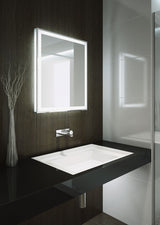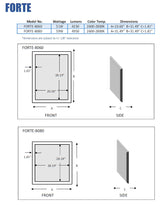



Aamsco Forte LED Backlit Mirror has Illuminated Side Glass Walls and an Illuminated Border - 2 Sizes
$1,057.48
$897



With its illuminated glass sidewalls and front-facing inset illuminated inset, the Forte by Aamsco creates a dramatic look. The illuminated glass sidewalls create a halo effect while the lighted "frame" provides plenty of light for the user. The LEDs are rated at 30,000 hours, and have a color temperature of 2,600k - 2,800k, Warm White, with a Color Rendering Index (CRI) of 90+. The mirror conforms to ADA guidelines and is suitable for damp locations such as the bathroom. It is also ETL listed. The light output is very bright at 4230 Lumens or 4950 Lumens, depending on the mirror size. Electrical consumption is small, at 51 Watts or 59 Watts, again depending on the mirror size. This is a hardwired mirror and requires an on-off switch. It is non-dimmable.
Features
- The Forte mirror by Aamsco has illuminated glass sidewalls that create a halo effect around the mirror. Additionally, the front-facing 1.65" illuminated border provides plenty of light for the viewer.
- The mirror is suitable for damp locations such as a bathroom. It can also be used for dramatic lighting in any room of the home, or in an office.
- 2 Sizes: Dimensions are 23.60" x 31.49" or square 31.49" x 31.49". Both sizes are 1.81" Deep, and held to a tolerence overall of 0.125". Surface mounted, and hardwired, either mirror can be mounted horizontally or vertically.
- The mirror consumes 51 Watts or 59 Watts and delivers 4230 Lumens or 4,950 Lumens, according to the size of the mirror. The LED color temperature is 2,600-2,800 degrees Kelvin, or Warm White with a CRI > 90. Non-dimmable.
- Conforms to ADA guidelines and is ETL listed. 3-Year manufacturer's warranty.
Aamsco
About Aamsco
 Aamsco, since 1975, has been manufacturing innovative lighting solutions for companies, wordwide. In the suburbs of New York City, their original vintage lighting company was formed by Bob Rosenzweig to manufacture antique light bulbs. With Bob's creativity, Aamsco began expanding and moved to New Jersy, and ultimately in 2001 relocated to Summerville, South Carolina where Aamsco continues to grow to this day.
Aamsco, since 1975, has been manufacturing innovative lighting solutions for companies, wordwide. In the suburbs of New York City, their original vintage lighting company was formed by Bob Rosenzweig to manufacture antique light bulbs. With Bob's creativity, Aamsco began expanding and moved to New Jersy, and ultimately in 2001 relocated to Summerville, South Carolina where Aamsco continues to grow to this day.
3,500k vs. 5,500k
Color Temperature Comparison

Color Temperature is not Brightness Color temperature describes the color of the light.
The color temperature of any light bulb, including LEDs is measured in degrees Kelvin ("k"). The higher the color temperature, the closer the light is to pure white light at 10,000° K. A blue sky sunny day at noon has a color temperature of about 5,500° K. On a very bright cloud-covered day, the sky registers a color temperature closer to white, of about 6,500° K., while a "regular" incandescent light bulb has a color temperature of about 2,700° K.
The color temperature of the lighting in your mirror may affect the way you apply your makeup and then how it's viewed by others, in a real-life situation. It's best, therefore, to choose a lighted makeup mirror with a color temperature to approximate your most frequent environment.
Many of our LED mirrors have their color temperature specified. And some makeup mirrors have adjustable or switchable color temperatures. For those where color temperature is not specified a reasonable guide is this: For incandescent bulbs, a color temperature of around 3,000° K. is normal. LEDs with no color temperature specification often have color temperatures around 4,000° K. The chart at right can serve as a guide.
The color temperature of any light bulb, including LEDs is measured in degrees Kelvin ("k"). The higher the color temperature, the closer the light is to pure white light at 10,000° K. A blue sky sunny day at noon has a color temperature of about 5,500° K. On a very bright cloud-covered day, the sky registers a color temperature closer to white, of about 6,500° K., while a "regular" incandescent light bulb has a color temperature of about 2,700° K.
The color temperature of the lighting in your mirror may affect the way you apply your makeup and then how it's viewed by others, in a real-life situation. It's best, therefore, to choose a lighted makeup mirror with a color temperature to approximate your most frequent environment.
Many of our LED mirrors have their color temperature specified. And some makeup mirrors have adjustable or switchable color temperatures. For those where color temperature is not specified a reasonable guide is this: For incandescent bulbs, a color temperature of around 3,000° K. is normal. LEDs with no color temperature specification often have color temperatures around 4,000° K. The chart at right can serve as a guide.
If you're planning for an outdoor day, the higher the color temperature the better. For evenings on the town, 2,700&deb; K. to 3,500° K. is best. For office environment lighting conditions, color temperatures around 4,500° K. provide the closest match.

About CRI
Color Rendering Index (CRI)

The color rendering index (CRI) is a measure of the ability of a light source to display the colors of various objects faithfully when compared the a natural light source. Light sources with a high CRI value are desirable in color-critical applications such as neonatal care and art restoration. Generally the higher the CRI, the more pleasing to the eye.
The highest possible CRI value is 100 and is frequently achieved by incandescent or "regular" light bulbs. Fluorescent "cool white" bulbs have a CRI of around 50 to 60, but some high-end multi-phosphor fluorescents can go up to 98. LEDs typically have an a CRI around 80, and better, more expensive LEDs can have CRIs up to 97 or 98.
The highest possible CRI value is 100 and is frequently achieved by incandescent or "regular" light bulbs. Fluorescent "cool white" bulbs have a CRI of around 50 to 60, but some high-end multi-phosphor fluorescents can go up to 98. LEDs typically have an a CRI around 80, and better, more expensive LEDs can have CRIs up to 97 or 98.








